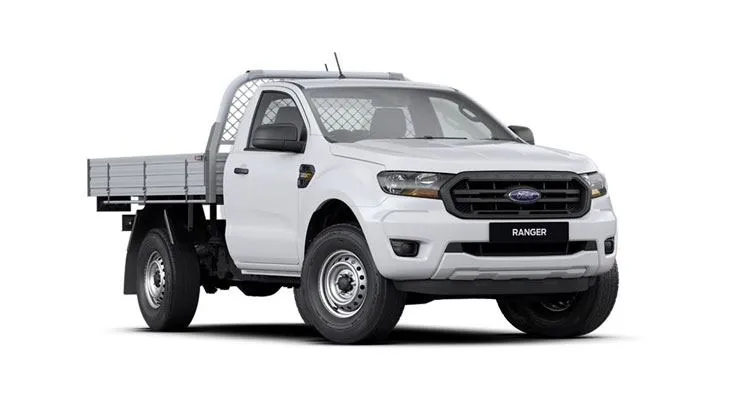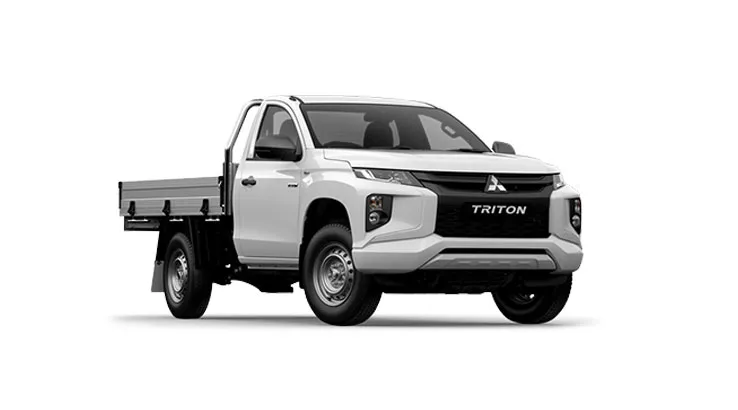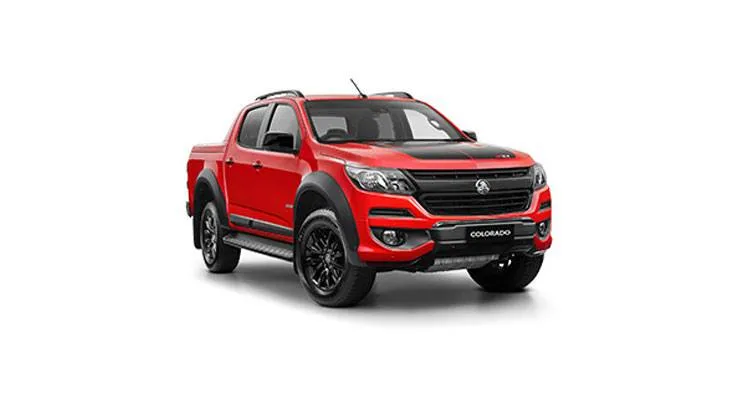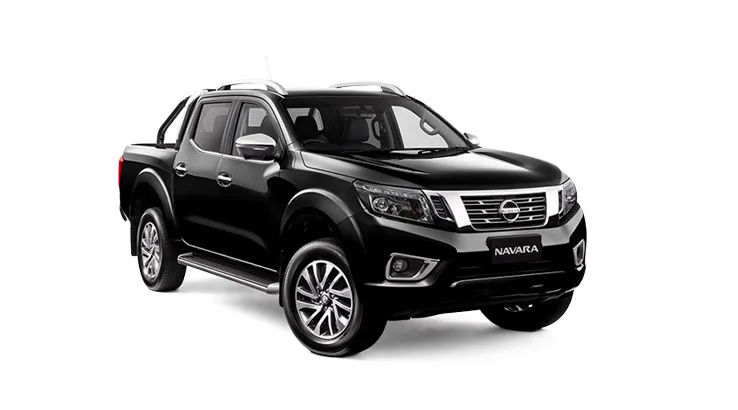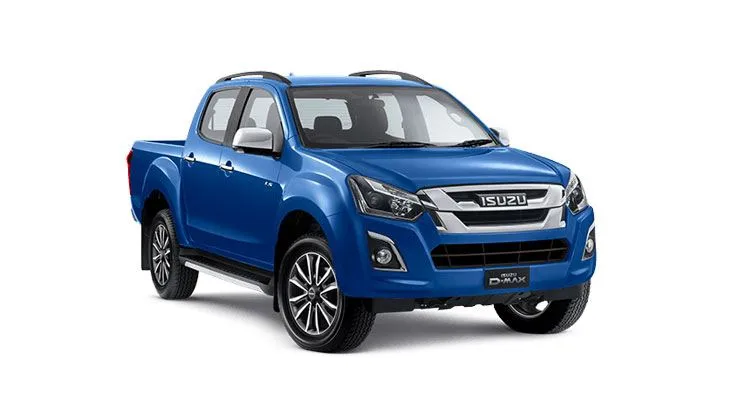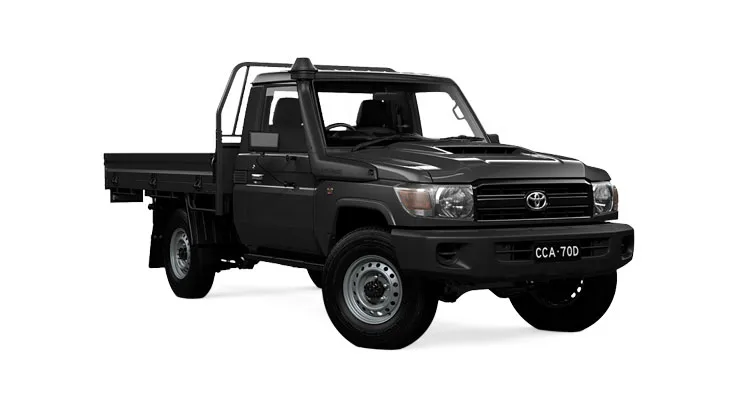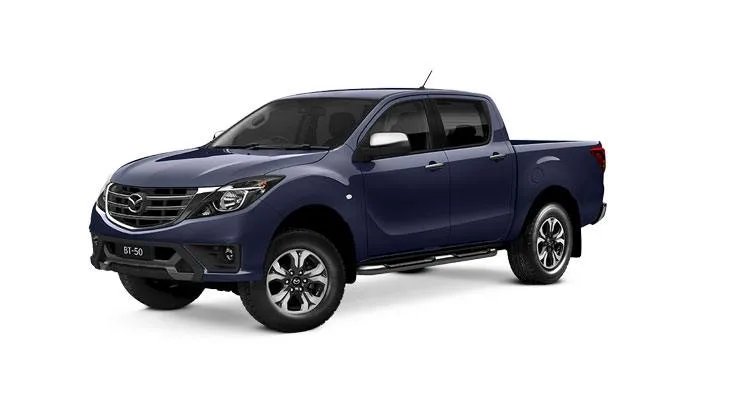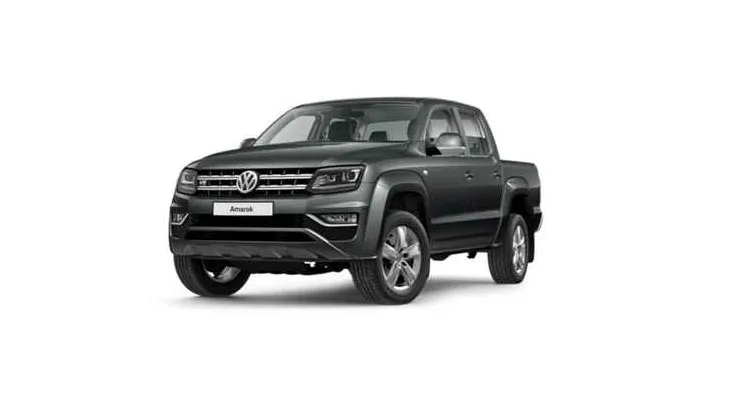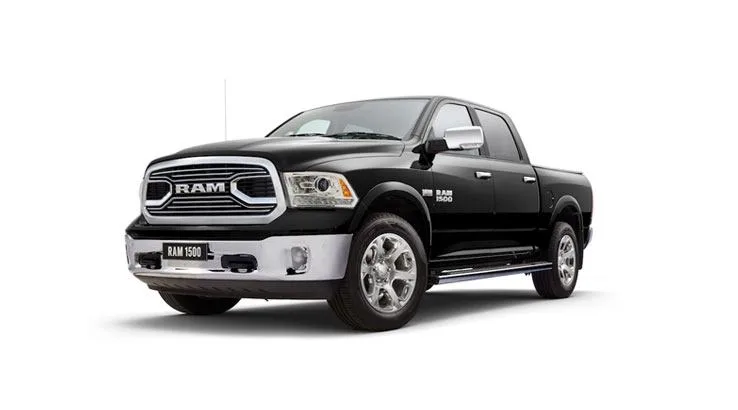In this series, we're comparing utes off-road. Previously, we've written about the best utes for tradies as well as the top all-round ute.
Here at Finder, we painstakingly compare ute reviews to determine the general findings of motoring experts on a vehicle. This saves you time and helps you understand the pros and cons of buying a particular pick-up. But what if, after reading our guides, you're still unsure about which ute to buy?
We've put together key off-road features and measurements of the most popular utes to see which is the most capable when the road ends and the less-travelled stuff starts.
What to look for in a 4x4 ute
When you need to travel over rough terrain, what should you look for in a ute?
- High ground clearance. This is the distance between the lowest point of the vehicle (almost always the diff case) and the ground you're travelling on. The larger this gap, the easier it'll be to travel over heavily undulating terrain without catching the belly of your ute. When the ute grounds out, then you risk damaging critical mechanical components – not good if you're in the middle of nowhere. To offset a lower ground clearance, look for utes with bash/skid plates also called underbody protection. You can improve your ground clearance by fitting larger wheels/tyres to lift the body up, but if you go too far, the treads will start rubbing on the body when the suspension is compressed.
- Bash plates. Ground clearance is important because it prevents you from getting stuck. Bash plates can also help reduce this by making your ute slide over rocks and other hard stuff. A good quality skid plate is generally made from thick steel, though some are aluminium. If you're venturing into really extreme off-road situations, you'll want to make sure your engine sump, gearbox, transfer case, diffs and fuel tank have some protection from rocks or branches jutting out of the ground.
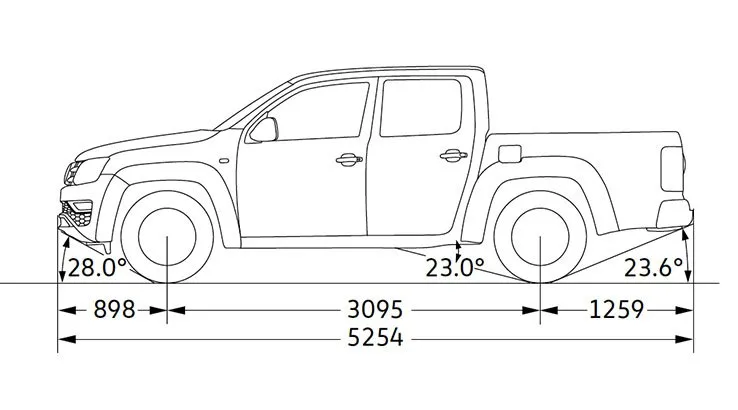
- Approach/Departure/Ramp angles. If you imagine drawing a line from the centre of the bottom of the tyre to the lowest point of the outer bodywork/towbar, when measured this gives your off-road angles. Approach tells you how steep a gradient you can tackle travelling forwards without damaging your front-end; departure is the steepest incline you can transition off without catching anything. If you picture a peak as a triangle, the breakover or ramp angle is the sharpest point you can travel over without clipping the apex on part of the underside of your vehicle. Ideally, you want the approach and departure angle numbers to be higher (picture a 90-degree angle, the closer to this figure you get, the better), while a higher ramp angle rating means you can go over more aggressive pitches without trouble. Bear in mind, these numbers are for low-speed movements, if you travel into a slope at speed, your suspension will compress and you could bottom out. These critical measurements are governed by ground clearance, overhangs and wheelbase. So, in theory at least, if you go for a ute with a shorter wheelbase, lifted higher from the ground and with minimal overhangs, you'll fair better off-road. Fun fact, a stock Hummer H1 can have a go at a 72-degree gradient.
- Overhangs. Generally, the shorter the overhang of your bodywork, measured from the centre line of your wheel to the outer extremity, the better. It means the bodywork and bumpers are lifted away from the terrain as much as possible, returning good approach and departure angles. If the car's components don't contact the ground, it lessens the chance of incurring damage.
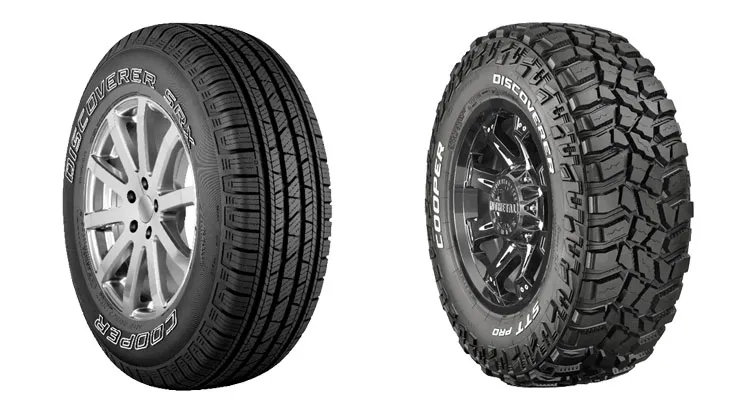
- Tyres. Tyres are very important when off-roading. The majority of utes sell with road tyres. These give better fuel economy, higher-speed ratings and make less noise. But when you go off-road, mud quickly gathers in the treads, making them almost perfectly smooth. As a result, grip will be diminished. To combat this, manufacturers produce all-terrain and mud tyres. Specifically designed to clear mud, thanks to larger gaps in the treads and with aggressive tyre blocks, a good quality all-terrain tread will give you better grip and keep you moving when the ground gets soft and mushy. The downside is they'll wear quicker, be noisy and also sometimes affect the braking distances and handling when on tarmac. If your chosen ute brand doesn't offer more aggressive tyres from the factory, it's not a big job to purchase a set of five (you'll want a matching spare) and have them swapped over onto your stock rims.
- Snorkel/engine breather. These aren't just to make you look like you know what you're doing out in the bush, they protect your engine from accidentally sucking in a load of liquid or dust. If you plan on travelling through deep water or into dusty, arid environments, you'll definitely want a snorkel. A lot of the utes below have factory options, but for some, you'll need to go to an aftermarket parts supplier.
- Winch. Winches are incredibly useful if you get stuck, need to move large objects that are blocking your way ahead or need to get a trapped vehicle out of the mud. You'll also need a solid winch bumper and a selection of straps, rated shackles, pulleys and gloves if you're going to use a winch. Recovery kits are available with these all kept in a neat bag. Be very careful when using a winch, if the cable or rope snaps, it can be deadly!
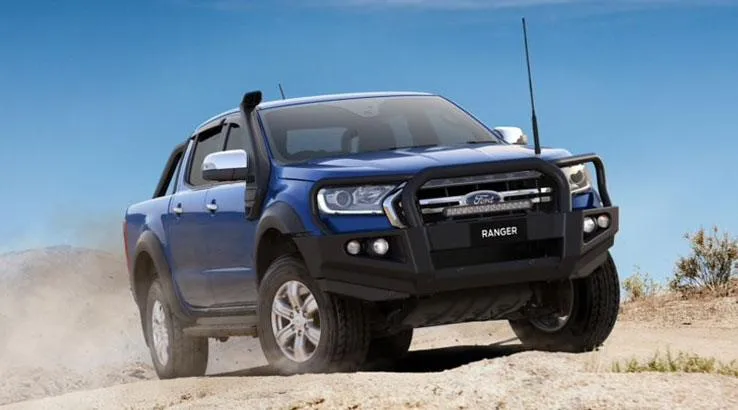
- Off-road bumpers. A bull bar is a good addition to an off-road ute as it gives you somewhere to attach spot lamps or fix a CB radio aerial. They can also deflect minor scrapes and dings as well as branches encroaching on your path. Some have integrated winch mounting locations as well as rated recovery/tow points.
- Rugged interior. You want a hard-wearing interior in your ute, so ditch carpet which will quickly be destroyed by abrasive grit in thick mud and go for something removable and made from tough rubber or vinyl. Then you can lift out your interior mats and give them a hose down, ready for your next trip.
- Electronic terrain modes. In the good old days, the driver was the one who manually operated the vehicle to get the best off-road performance. Nowadays, the driver receives assistance from a number of electronic systems such as hill descent control (where fitted), traction control and, on some utes, a terrain response system. If you're really serious about driving off-road, you'll want front and rear diff lockers to stop a wheel that's in the air from spinning and to keep you ploughing through sticky mud. A centre diff is even more useful, locking both axles together so they turn in unison.
- Gearing and transmission. A low-range transfer box is a must. It allows you to change the effective gear ratios of your car, reducing them so that the speed you're travelling at is less for the same engine revs. This helps with slow-speed manoeuvres but also gives you more control and is advantageous whenever you might lose grip in 4WD high. A low ratio will give a driver more control on hill descents too, where you'll make the most of engine braking. Again, having extra gears (the Ford Ranger has ten gears on some models) helps maximise the command you have over your vehicle, squeezing the optimum from the engine and augmenting traction.
- Suspension. Suspension plays a key role in a good off-roader. Long travel dampers help keep the wheels planted even when you get into cross-axle situations. Twin shocks cope with heat and corrugations better, lasting longer before they get wallowy. Independent suspension allows all four corners to conform to the ground underneath them. Soft suspension will be more comfortable off-road, while less flexible damping will see the body move around more when crossing gullies at an angle.
- Lighting. Having extra spot lamps and light bars can mean the difference between being forced to park-up and camp as dusk sets in or having the ability to drive on into the night.
- Equipment storage. Roof bars and racks are a great place to store things like bikes or even a roof tent and canopy. You can also stick your off-road jacks up there. Some off-roaders might feel comfortable putting extra fuel cans and spare tyres on the roof, though you'll need to make sure you're not unbalancing the ute and not exceeding the factory specified maximum weight. A rear canopy over the tub is great if you've got dogs you take off-roading since it stops them from jumping out and also extends the usable roof storage space.
A few words about off-roading
If you're an inexperienced off-road driver, you should consider taking a training course. It isn't just a case of point and shoot, poor technique will result in injuries or worse. Here are a few pointers to remember:
- Keep your thumbs out of the wheel. People have had their thumbs broken by allowing them to sit inside the outer rim of the steering wheel. When the wheel hits a rock or follows a rut, it can violently spin the wheel and send you into a world of pain. Instead, place your thumbs on the outer edge of the wheel pointing up, then if the wheel turns abruptly, your thumbs will slide along the outer edge, clear of the inner spokes/boss.
- Walk your line first. It's always wise to stop your vehicle safely and walk a route you want to take first. This way, you can look out for, and shift, any large rocks while plotting out a deliberate line to drive along. Ideally, you'd always travel in a convoy in case of mechanical failures. This way, there are others around to spot you as you travel over rough rocks and give directions. They can also help if you bury your ute in a thick slurry of mud.
- Do not underestimate water. Fast flowing water is a killer. It doesn't take much water to sweep someone off their feet or to shift a heavy 4x4. Water can be deeper than you think and contain unseen objects. Where safely viable, you should inspect a water crossing and check the depth before committing to wading through it.
Toyota HiLux
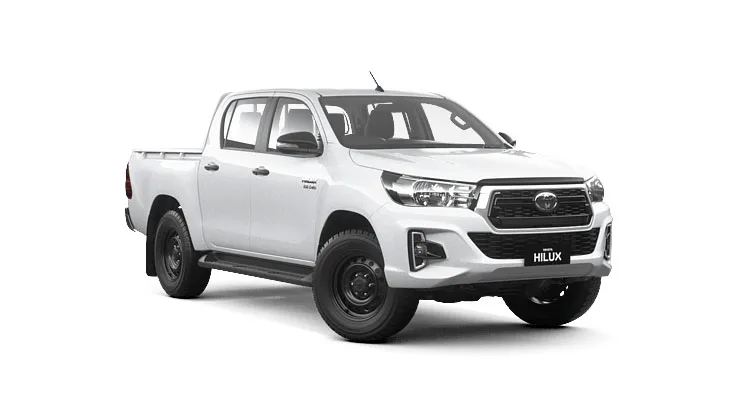
| Overhangs (Front/rear) | 928mm/1,234mm |
|---|---|
| Ground clearance (worst model) | ~216mm (Rogue) |
| Wheelbase | 3,085mm |
| Nationwide dealers | 310 |
| Towing capacity | Up to 3,500kg (or 3,200kg for auto models) |
| Wading depth | 700mm |
| Fuel tank | 80 litres |
| Turning circle | Not listed |
| Suspension | Heavy-duty suspension available with underbody package on Hi-Rider HiLuxs |
| Underbody shielding | Yes, on Hi-Rider models |
| Rubber matting | Vinyl floor covering available |
| Measurements: external (L, W, H) | 5,415mm x 1,885mm x 1,815mm |
| Wheel arch protectors | Rugged, Rugged X |
| Rock sliders | Rugged, Rugged X |
| Recovery points | Rugged, Rugged X |
| Snorkel | Rugged, Rugged X |
| Reversing camera | Pick-up models |
| Rear diff-lock | SR models and upwards |
| Dual ratio transfer box | Yes |
| Downhill assist | Pick-ups from the SR double-cab upwards |
| Terrain dial | No dial or button, but various separate systems |
| Comments | Toyota has a huge number of dealers, which should reduce the distance new parts have to travel for crucial repairs. Also, an 80-litre fuel tank is impressive, giving you a decent off-road range before you have to dip into your jerry cans. |
* Rugged and Rugged X models have 1,087mm and 1,082mm overhangs respectively
Ford Ranger
| Overhangs (Front/rear) | 1,000mm*/1,245mm |
|---|---|
| Ground clearance (worst model) | ~232mm (XLS), rest 237mm |
| Wheelbase | 3,220mm |
| Breakover angle | 24/25° depending on model |
| Approach angle | 28/29° depending on model |
| Departure angle | 21-28° depending on model |
| Nationwide dealers | 197 (as of 2014) |
| Towing capacity | Up to 3,500kg |
| Wading depth | 800mm |
| Fuel tank | 80 litres |
| Turning circle | 12.7 metres |
| Suspension | Raptor model has performance suspension |
| Underbody shielding | Ranger Raptor has bash plates |
| Rubber matting | On XL Rangers |
| Measurements: external (L, W, H) | 5,382mm x 2,163mm x 1,815mm |
| Wheel arch protectors | Optional flares |
| Rock sliders | Aftermarket option |
| Recovery points | Aftermarket part available |
| Snorkel | Optional accessory |
| Reversing camera | Pick-up models |
| Rear diff-lock | Electronic diff |
| Dual ratio transfer box | Yes |
| Downhill assist | Yes |
| Terrain dial | No dial or button, but various separate systems |
| Comments | Ford offers an optional CB radio with antenna kit, an LED light bar and a bull bar, among other things from the factory. |
Mitsubishi Triton
| Overhangs (Front/rear) | Not listed/Not listed |
|---|---|
| Ground clearance (worst model) | ~205mm (GLX) |
| Wheelbase | 3,000mm |
| Breakover angle | 25° (some 24°) |
| Approach angle | 27.5°-31° |
| Departure angle | 22°-23° |
| Nationwide dealers | 200+ |
| Towing capacity | Up to 3,100kg |
| Wading depth | 500mm |
| Fuel tank | 75 litres |
| Turning circle | 11.8 metres |
| Suspension | Some have heavy-duty suspension |
| Underbody shielding | Yes |
| Rubber matting | Vinyl floor covering available |
| Measurements: external (L, W, H) | 5,305mm x 1,815mm x 1,780mm |
| Wheel arch protectors | Aftermarket |
| Rock sliders | Aftermarket |
| Recovery points | Aftermarket |
| Snorkel | Aftermarket |
| Reversing camera | Pick-up models |
| Rear diff-lock | GLX+ and upwards |
| Dual ratio transfer box | 4x4 models |
| Downhill assist | GLS Premium |
| Terrain dial | Super Select II |
| Comments | The Triton has some unique features that make it on-paper a decent off-roader. Multi-around view could be useful when navigating tight gullies. A factory bull bar, LED light bar and all-terrain tyre option round out the equipment. |
Holden Colorado
| Overhangs (Front/rear) | Not listed/Not listed |
|---|---|
| Ground clearance (worst model) | ~215mm |
| Wheelbase | 3,096mm |
| Breakover angle | 22.1° |
| Approach angle | 28.3° |
| Departure angle | 23.1° |
| Nationwide dealers | 207 |
| Towing capacity | Up to 3,500kg |
| Wading depth | 600mm |
| Fuel tank | 76 litres |
| Turning circle | 12.7 metres |
| Suspension | Coil spring, leaf spring rear (heavy-duty option as part of Xtreme pack on Z71) |
| Underbody shielding | All models have sump guard, Z71 has stage 1 underbody protection. Farmer pack adds stage 1-3 bash plating. |
| Rubber matting | Vinyl floor covering available |
| Measurements: external (L, W, H) | 5,362mm x 1,872mm x 1,800mm |
| Wheel arch protectors | LS-X models and up |
| Rock sliders | Aftermarket |
| Recovery points | Up to 1,500kg |
| Snorkel | Factory option |
| Reversing camera | Yes |
| Rear diff-lock | DuraGrip system with LSD |
| Dual ratio transfer box | 4x4 models |
| Downhill assist | Hill descent control |
| Terrain dial | Part of Electronic Stability Control (ESC) |
| Comments | Factory packs quickly add up. |
Nissan Navara
| Overhangs (Front/rear) | Not listed/Not listed |
|---|---|
| Ground clearance (worst model) | ~217mm (RX) |
| Wheelbase | 3,150mm |
| Nationwide dealers | 89 |
| Towing capacity | Up to 3,500kg |
| Wading depth | 600mm |
| Fuel tank | 80 litres |
| Turning circle | 11.8-12.4m (depending on iteration) |
| Suspension | Double front wishbones, rear five-link suspension |
| Underbody shielding | Aftermarket parts available |
| Rubber matting | Vinyl floor covering available, rubber mats optional |
| Measurements: external (L, W, H) | 5,120mm (5,255 on some) x 1,850mm (not including mirrors) x 1,790mm |
| Wheel arch protectors | On N-TREK Navaras |
| Rock sliders | Aftermarket |
| Recovery points | Aftermarket |
| Snorkel | Aftermarket |
| Reversing camera | Available on all pick-up models |
| Rear diff-lock | Limited slip diff on 4WD models, electronic locking rear diff on SL, ST, ST-X |
| Dual ratio transfer box | On 4x4 models, yes |
| Downhill assist | ST-X and up |
| Terrain dial | No dial or button, but various separate systems |
| Comments | 360° could be useful when off-roading for spotting branches, rocks and other damaging objects. 360° view can be affected by the add-on bumpers though. |
Isuzu D-MAX
| Overhangs (Front/rear) | 905mm/~Up to 1,295mm |
|---|---|
| Ground clearance (worst model) | ~225m |
| Wheelbase | 3,095mm |
| Nationwide dealers | 156 |
| Towing capacity | Up to 3,500kg |
| Wading depth | 800mm |
| Fuel tank | 76 litres |
| Turning circle | 12.6m |
| Suspension | Double-wishbones front, leaf-springs on rear |
| Underbody shielding | Front steel bash plate, 4x4s have sump, transfer box plus fuel tank protection |
| Rubber matting | Vinyl floor covering available, rubber mats as an accessory |
| Measurements: external (L, W, H) | 5,295mm x 1,860mm (not including mirrors) x 1,785mm |
| Wheel arch protectors | Fender flares as a factory option (heavy-duty side rail factory option) |
| Rock sliders | Aftermarket |
| Recovery points | Factory fitted rated tow hooks, up to 2,850kgs limit |
| Snorkel | Factory option |
| Reversing camera | Available on all pick-up models |
| Rear diff-lock | No (Aftermarket airlocks for sale) |
| Dual ratio transfer box | On 4x4 models, yes |
| Downhill assist | Yes |
| Terrain dial | Terrain Command |
| Comments | Isuzu's optional side rail protection is unique among factory fitted options, apart from on the Toyota LandCruiser 70. |
Toyota LandCruiser 70
| Overhangs (Front/rear) | Not listed/Not listed |
|---|---|
| Ground clearance (worst model) | ~230mm |
| Wheelbase | 3,180mm |
| Breakover angle | Not listed |
| Approach angle | Not listed |
| Departure angle | Not listed |
| Nationwide dealers | 310 |
| Towing capacity | Up to 3,500kg |
| Wading depth | 700mm |
| Fuel tank | 130 or 180 litres |
| Turning circle | 14.4 metres |
| Suspension | Front coil springs and radius arm, rear lead springs |
| Underbody shielding | Aftermarket available |
| Rubber matting | Optional all-weather mats |
| Measurements: external (L, W, H) | 5,230mm x 1,870mm (not including mirrors) x up to 2,115mm |
| Wheel arch protectors | Some models have over fender flares |
| Rock sliders | Aftermarket |
| Recovery points | Aftermarket |
| Snorkel | Standard |
| Reversing camera | Aftermarket available |
| Rear diff-lock | Optional on some |
| Dual ratio transfer box | Yes |
| Downhill assist | No |
| Terrain dial | Has Active Traction Control (A-TRAC) and Vehicle Stability Control (VSC) |
| Comments | Single-cab models have a five-star ANCAP rating. Looks like an older vehicle, but boasts some of the more modern comforts. It's a stout and robust vehicle, with a crazy huge fuel tank. |
Mazda BT-50
| Overhangs (Front/rear) | 919mm/Up to 1,226mm |
|---|---|
| Ground clearance (worst model) | ~200mm (XT) |
| Wheelbase | 3,220mm |
| Breakover angle | 25° (some 24.4°) |
| Approach angle | 27.2°-28.2° |
| Departure angle | 26.4°-28.4° |
| Nationwide dealers | 134 |
| Towing capacity | Up to 3,500kg |
| Wading depth | 800mm |
| Fuel tank | 80 litres |
| Turning circle | 12.4 metres |
| Suspension | Front double-wishbones with coils, rear axle with leaf springs |
| Underbody shielding | Yes, on 4x4 models |
| Rubber matting | Vinyl floor covering, rubber mats available |
| Measurements: external (L, W, H) | 5,365mm-5,373mm x 1,850mm (not including mirrors) x 1,821mm |
| Wheel arch protectors | Optional (apart from on Boss model) |
| Rock sliders | Aftermarket |
| Recovery points | Aftermarket |
| Snorkel | Optional accessory |
| Reversing camera | Yes |
| Rear diff-lock | Locking rear diff on Freestyle and up |
| Dual ratio transfer box | Yes |
| Downhill assist | Yes, hill descent control (HDC) |
| Terrain dial | Variety of systems |
| Comments | Some of the Mazda BT-50s have a locking rear diff, sat-nav with off-road maps and various other off-road potential boosting features. It's also cool to see the Boss adventure pack that brings various adventure kit like a bull bar and driving lights. The BT-50 shares a platform with the Ford Ranger. |
VW Amarok
| Overhangs (Front/rear) | 898mm/Up to 1,259mm |
|---|---|
| Ground clearance (worst model) | ~226mm (TDI400) |
| Wheelbase | 3,095mm |
| Breakover angle | 23° |
| Approach angle | 28° |
| Departure angle | 23.6° |
| Nationwide dealers | 106 |
| Towing capacity | Up to 3,000kg |
| Wading depth | 500mm |
| Fuel tank | 80 litres |
| Turning circle | 12.95 metres |
| Suspension | Front double-wishbones with coils, rear axle with leaf springs |
| Underbody shielding | Yes, on 4x4 models |
| Rubber matting | Rubber mats in cab |
| Measurements: external (L, W, H) | 5,254mm x 2,228mm x 1,834mm |
| Wheel arch protectors | Optional (apart from on Boss model) |
| Rock sliders | Aftermarket |
| Recovery points | Aftermarket |
| Snorkel | Aftermarket |
| Reversing camera | Yes |
| Rear diff-lock | Electronic and mechanical diff lock |
| Dual ratio transfer box | Yes |
| Downhill assist | Yes, hill descent control (HDC) |
| Terrain dial | Off-road mode |
| Comments | A well-reviewed 4WD system, underpinned by renowned German engineering. The gearing also seems very favourable for off-roading. |
RAM 1500
| Overhangs (Front/rear) | 905mm/~Up to 1,295mm |
|---|---|
| Ground clearance (worst model) | ~235m |
| Wheelbase | 3,569mm |
| Nationwide dealers | 52 |
| Towing capacity | Up to 4,500kg |
| Wading depth | N/A |
| Fuel tank | 98 litres |
| Turning circle | 13.9m |
| Suspension | Twin shocks, double-wishbone at front, rear five-link with twin dampers |
| Underbody shielding | Aftermarket available |
| Rubber matting | Rubber floor covering |
| Measurements: external (L, W, H) | 5,817mm x 2,017mm (not including mirrors) x 1,917mm |
| Wheel arch protectors | Aftermarket |
| Rock sliders | Aftermarket |
| Recovery points | Aftermarket |
| Snorkel | Aftermarket |
| Reversing camera | Available on Laramie |
| Rear diff-lock | Anti-spin diff |
| Dual ratio transfer box | Yes |
| Downhill assist | No |
| Terrain dial | Traction control |
| Comments | The Ram 1500 should handle gravel roads and mud, but it's a heavy and large beast. |
Which ute is the best off-road?
From research, it would appear the three best-selling utes are also very competent off-road vehicles. The Ford Ranger is highly rated, thanks to its impressive wading capability, powerful yet frugal diesel engines and modern ten-speed box. The HiLux fares well too as does the Triton with its Super Select II terrain response system. The 70 Series LandCruiser is also rated highly and the Mazda BT-50 is based on the Ford Ranger, so it should be able to take care of itself off the bitumen. Car reviewers also favourably rated the Volkswagen Amarok, specifically the V6 model (some even say it is the best off-road).
At the end of the day, very few ute owners spend more than even half of their time off-road. You need to weigh how well the 4x4 copes with on-road, day-to-day travelling against its abilities off the paved road network. You also have to factor in things like value for money, fuel economy, passenger comfort, equipment levels and servicing fees. Remember, if you do a lot of travelling off-road, all manufacturers will consider this a harsh working environment and you'll need to service your ute more frequently, with shorter distance intervals.
One of the best things about owning a ute is if you want to improve its ability off-road, you can relatively easily modify it. Installing suspension lift kits, larger tyres, underbody protection and a winch will see you travelling to places you'd never think possible.
Compare some options to finance ute
Recent car reviews
Pictures: Supplied
More guides on Finder Shopping
-
Hyundai Ioniq 5 N Review
The future’s electric – and it wants to burn rubber
-
2025 Genesis G70 Review
It's faster than a BMW 3 Series, more unique than a Mercedes C-Class and loaded with features that make it feel every bit as premium.
-
Volkswagen Golf Mk8.5: More tech, more power, more excuses to upgrade?
The VW Golf is back - and it's got more of everything.
-
Sharper, smarter and better value: The 2025 Skoda Octavia RS lands in Australia
Skoda refines its family-friendly performance car with more features, more power and a competitive price.
-
2024 Peugeot E-Expert Van Review
Peugeot have made a van that whispers while it works.
-
2024 Toyota GR Corolla review
Toyota gave a Corolla muscles and a megaphone and it’s glorious.
-
2024 Jeep Wrangler Review
Born for the trail, adapted for the tarmac
-
SUV reviews
Let us assist you in picking your next SUV.
-
Best small cars
There are dozens of different makes and models to choose from and then about five different trim levels on average, per carmaker. This guide will help you cut through the sales banter.
-
Electric Car Reviews 2025
Which electric car should you buy in 2021? Find out with our complete EV guide.

